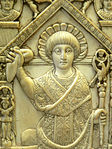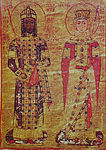Loros
The loros (Greek: λῶρος, romanized: lôros) was a long, narrow and embroidered cloth, which was wrapped around the torso and dropped over the left hand. It was one of the most important and distinctive parts of the most formal and ceremonial type of imperial Byzantine costume, worn only by the Imperial family and a few of the most senior officials. It developed out of the trabea triumphalis of the Roman consuls. There were different male and female versions.[1] Byzantine sources speak of the "loros costume" as the loros dictated the rest of the imperial outfit. The slightly less formal, and more secular, imperial costume, which was also that normally worn by high officials on official occasions, was the chlamys costume.[2] Underneath either the loros or the chlamys were worn the divetesion (διβητήσιον), a long silk robe, and a tunic.[3]
Male

The first representations of the loros are on coins from the reign of
Although in practice it was, according to the
The loros was also worn at Easter by the "twelve dignitaries", holders of the ranks of
From the 13th century the loros began to be shown worn in imperial portraits of other Orthodox rulers, such those of Serbia, Georgia and the Armenian Kingdom of Cilicia. In the Bulgarian Gospels of Tsar Ivan Alexander, the tsar and his son both wear it.[13]
Female

At first empresses wore essentially the same form as emperors, but from around the 9th century a new style appears. The hanging end was longer and much broader, and after reaching down to the ankles turned upwards to be folded over the left forearm, or fastened or tucked into the belt. The wide end has the appearance in paintings of a round-topped shield tapering to a point, at an oblique angle.[14] In the 13th century this shield shape is no longer seen, and the female form returns to being that of the now modified male one for the last phase of the empire.[15] Empresses also wore a wide jewelled "superhumeral" collar in matching styles to the loros, and perhaps attached to it. This was the distinctive garment of empresses and also worn on other occasions, and copied by other upper-class women; the modified male loros created much the same effect.
Gallery
-
A Roman consul wearing the trabea triumphalis, 517 AD
-
Constantine VII wearing the traditional loros though not accurately wrapped, 945 AD
-
The Romanos Ivory showing emperor Romanos wearing an accurate modified loros, probably 945–949 AD
-
John II Komnenos. Although the relief is anachronistic and the emperor wears simultaneously both the loros and the chlamys (the coat on top), something which was never the practice, the wrapping of the loros beneath is carved accurately, 1143 AD.
-
Manuel I Komnenos wearing the modified loros, 12th century
-
Andronikos II Palaiologos, r. 1272–1328
-
Gospels of Tsar Ivan Alexander, 1355–56, portrait of the Bulgarian tsar and his family
-
A fresco of Georgian King David IV (r. 1089–1125) from Gelati Monastery
Notes
References
- Grierson, Philip (1973). Catalogue of the Byzantine Coins in the Dumbarton Oaks Collection and in the Whittemore Collection, Volume 3, Part I. Washington, DC: Dumbarton Oaks. ISBN 9780884020455.
- Maguire, Henry (2004) [1997]. Byzantine Court Culture from 829 to 1204. Washington, DC: Dumbarton Oaks. ISBN 978-0-88402-308-1.
- Parani, Maria G. (2003). Reconstructing the Reality of Images: Byzantine Material Culture and Religious Iconography (11th–15th Centuries. Leiden: Brill. ISBN 9004124624.








